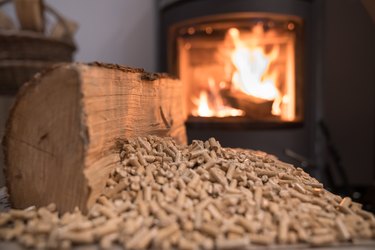
Installing a pellet stove in an existing chimney is a great way to avoid the hassle of cutting into a wall or through the roof to properly vent the stove. However, don't fall into a false sense of security when using a chimney to vent a pellet stove, because a house fire could result from improper installation. Although pellet stove chimney adapters come with written instructions for homeowners, consider calling a professional to perform this installation instead of going the do-it-yourself route.
First, Get a Chimney Inspection
Video of the Day
Chimney fires are a real and present danger any time a heat source vents through the flue. Call a chimney inspector to evaluate the inside of your chimney for excess creosote buildup and structural defects. Any problems must be remedied before continuing with the pellet stove installation process.
Video of the Day
While you're in the preparation stage, make another phone call to your local fire marshal to ask if the law requires a permit or a pellet stove installation inspection. Even if such an inspection isn't legally required, it's smart to schedule one.
Install a Chimney Liner
Installing a pellet stove pipe in an existing chimney requires a chimney liner. This is a metal pipe that attaches to the pellet stove at one end — typically with a pellet stove pipe chimney adapter — and extends all the way through the chimney and above the roof at a suitable clearance. A 1/2-inch layer of insulating material will also be wrapped around the chimney liner to keep the air hot as it travels up the chimney, thus reducing dangerous creosote buildup.
Once the chimney professional wraps the liner with insulation, they'll go onto the roof and feed the liner all the way down into the chimney. The chimney liner must extend above the roofline to meet the minimum clearance requirements outlined in your local ordinances. After the liner is in the proper position, it will be secured with a top plate and weatherized with a cap.
Pellet Stove Pipe Chimney Adapter
Back inside at the fireplace, an adapter will be clamped onto the end of the liner and sealed with a fire seal. Then your contractor will scoot the pellet stove in front of the fireplace, line up the exhaust hole with the chimney liner and make sure it connects securely and is sealed properly.
One of the reasons why it's important to hire a professional is to make sure this connection is made correctly so that creosote falls into the stove to be burnt, rather than falling around the stove, where it poses a fire and health hazard, according to the CDC.
The pellet stove also needs to be positioned in front of the fireplace with proper clearance from the wall or any other objects to reduce the risk of a house fire as the pellet stove radiates heat. Verify the recommended clearances by reading the owner's manual that came with your pellet stove. As a final precaution, have your pellet stove installation inspected by the fire department even if it's not required by law.